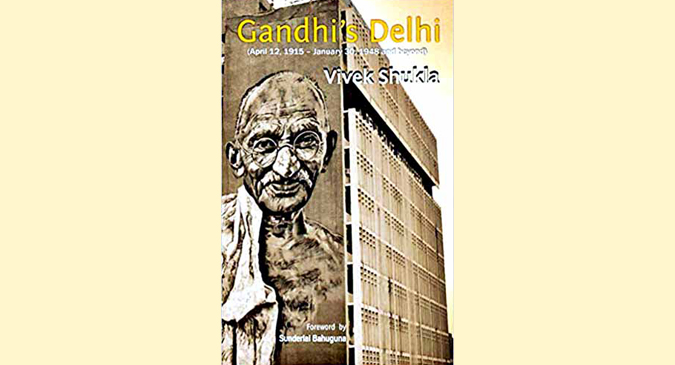Gandhi’s Delhi, Vivek Shukla, Publisher : Anuugya Books, Pp : 112, Price: Rs. 200
As we celebrate the 150 birth anniversary of Father of the Nation, a new book details interesting and unknown facts about Gandhiji’s last days in the capital. Gripping!
Bhaskar Ramamurthy
‘GANDHI’S DELHI’, a book authored by Vivek Shukla, historian and journalist, is a gripping tale of the Mahatma’s intimate association with Delhi, where he spent his last days. With a style of narration so simple, informal and straight, I got to know so many facts about Mahatma Gandhi, while reading this book, that was unknown to me till then.
The chapter ‘Two Icons’ discusses the delicate relations between Bapu and Baba Saheb Ambedkar. The book also throws light on some unknown facts about Harilal Gandhi, the first son of Bapu. While it is still not clear whether he was there at the funeral of his father or not, it is a fact that his estranged son suddenly appeared at his Connaught Place residence of his younger brother, Devdas, after a couple of days of Gandhiji’s death.

Vivek shukla has painstakingly woven together the events of Mahatma’s life in Delhi in those tumultuous, pre-Independence days. Though by now, we are quite familiar with the teachings and life of Gandhiji, yet the care with which the author has joined the dots in Gandhiji’s Delhi life is remarkable.
Did Mahatma Gandhi not make any effort to save Bhagat Singh from the gallows? How was Gandhi’s relationship with son Harilal? The author attempts to provide answers in this book. The book only focuses only on his days in Delhi. Since his maiden visit in 1915, Delhi became his ‘home’. He spent his last 144 days at the Birla House (now Gandhi Smriti). He also lived at Valmiki Mandir, Panchkuian Road for more than 200 days, Harijan Sewak Sangh, Kingsway Camp and at the house of Dr. Ansari at Ansari Road, Darya Ganj.
Shukla says, “He inaugurated the Birla Mandir on a condition. He told the Birla family that he would inaugurate it only if dalits were allowed entry to the temple. These subjects were almost neglected by the researchers on Gandhiji. So, I thought of doing justice to these subjects.”
The book reveals some unknown facts about Birla House becoming Gandhi Smiriti. It tells you in great detail about the making of Rajghat, the architect of Rajghat, the background of Bapu’s statues and murals in the Capital.
Interestingly, the book reveals how Gandhiji became a teacher. He used to teach English and Hindi. Even elderly men and women would join his classes. He was a very strict teacher. That black board of his class room has been preserved.
It also tells you that Delhi was another Noakhali for Gandhiji. After quelling riots in East Bengal, he went on a fast to put moral pressure on miscreants in Delhi after the Partition in 1947. His fast had a magical impact and riots were controlled.
Gandhi ji had visited Birla Mandir and Dargah Bakhtiar Kaki on a very important mission. The book tells you the reasons for his making the trips there. It is important to know why. There are separate chapters on Bapu’s ties with Jamia Millia Islamia University and FICCI. He was the life and soul behind the making of both these institutions.
In over 20 chapters, you would find many other defining moments of Mahatma Gandhi in Delhi. A must read book for its fluid, informal style of narrative, full of insights into the life of Gandhiji in Delhi. Lastly, it has some of the most exclusive pictures.
(The writer is an author, historian, and journalist)














Comments